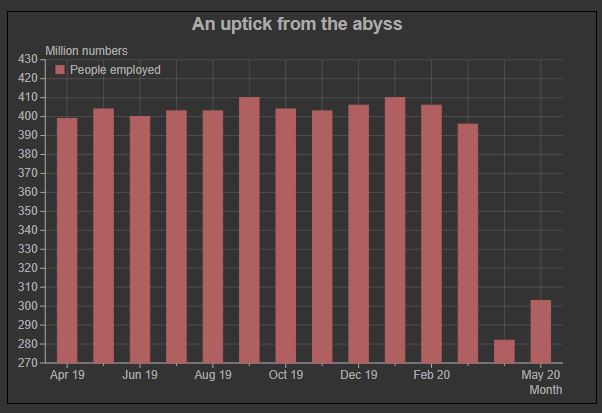Hyderabad: The Centre for Monitoring Indian Economy (CMIE) has said that although the unemployment rate remained very high at 23.5 per cent in May 2020, labour market conditions improved during the month. The labour participation rate and the employment rate improved significantly. The total number of people employed increased by 21 million during May 2020.
The unemployment rate at 23.5 per cent in May 2020 was the same as it was in April 2020. But, the labour participation rate improved from 35.6 per cent to 38.2 per cent and the employment rate improved from 27.2 per cent to 29.2 per cent.

While the main labour market metrics indicate an improvement in May compared to April, the labour market conditions still remain much weaker than they were before the lockdown.
Compared to the 404 million people employed, on average, in 2019-20, employment in May 2020 was 303 million. Over a 100 million people were still out of jobs compared to employment in 2019-20. Nevertheless, this is an improvement over the situation in April 2020 when employment had fallen to 282 million implying a loss of nearly 122 million compared to the average employment in 2019-20.
Between April and May 2020, while the count of those employed increased by 21.2 million, the count of unemployed also increased by 6.3 million. The labour force increased substantially, by 27.5 million.
A number of people who had left the active labour markets in April returned back in May. People who had left the labour market in April because of large-scale job losses, had parked themselves in the passive unemployed category. They declared themselves as unemployed and willing to work but not actively looking for jobs.
In May, many of these were back, actively looking for jobs. The increase in jobs in May had possibly influenced the passive unemployed labour force to become active.
Of the 21 million jobs that got added in May, 14.4 million were of small traders and wage labourers. This workforce was the most vulnerable to the lockdown. They account for about a third of the total employed population.
In April, 71 per cent of them had lost jobs. As the economy has been opening up gradually in parts of the country, these are back to their business. Since these are predominantly self-employed persons it is relatively easy for them to resume work when conditions permit.
Read more:Lockdown has flattened GDP curve not Covid's: Bajaj to Rahul
The 21 million job increase in May translates into a 7.5 per cent increase in jobs over April. Jobs of small traders and wage labourers increased by a massive 39 per cent.
Jobs of business persons increased by 9.3 per cent in May. Of the 18.2 million jobs of business persons lost in April, 5.5 million jobs came back. Employment in the farm sector continued to grow. It grew by 1.4 million or 1.2 per cent in May over April.
The sole segment that did not see any increase in jobs in May was that of the salaried employees. The number of salaried jobs declined very marginally from 68.4 million in April to 68.3 million in May 2020. These used to be 86 million in 2019-20.
Salaried jobs are relatively difficult to get. And, salaried jobs lost during a lockdown are far more difficult to recover. These are also the better jobs. The continued loss of good quality jobs is therefore worrisome.
Age distribution of the 21 million jobs that were added during May 2020 shows a similarly worrisome statistic. While employment increased in all age groups by different quantities, employment in the 25-29 year age group declined.
The decline was small - from 30.8 million employed in this age bracket in April 2020 to 30.5 million in May 2020. Yet, being the only age group to suffer a fall in May besides those over 65 years of age, it stands out as a sore thumb.
The increase in jobs in May 2020 reflects a partial lifting of the lockdown. Such a partial lifting could have generated only those informal jobs of the self-employed that are in the unorganised sectors.
It could not have generated jobs for the 25-29 year old who principally seek better quality jobs. It could not have created jobs for salaried employees either. Salaried jobs will increase in a meaningful sense only when investments increase. This is a distant dream.
In the last week of May that ended on the 31st, the unemployment rate fell to 20.2 per cent. This is the lowest unemployment rate recorded since the imposition of the lockdown. The labour participation rate had risen to 38.7 per cent. Most importantly, the employment rate was at its highest since the lockdown, at 30.9 per cent.



